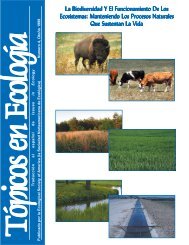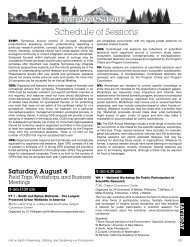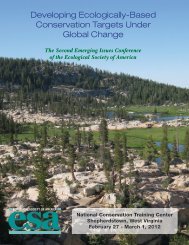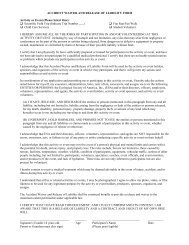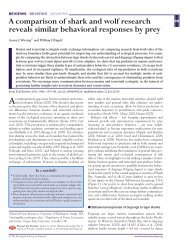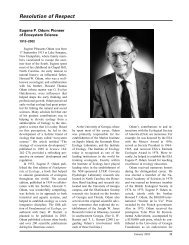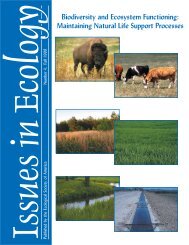Printed Program (PDF) - Ecological Society of America
Printed Program (PDF) - Ecological Society of America
Printed Program (PDF) - Ecological Society of America
Create successful ePaper yourself
Turn your PDF publications into a flip-book with our unique Google optimized e-Paper software.
Herwig2, JB Cotner3 and WO Hobbs4, (1)University <strong>of</strong> St<br />
Thomas, (2)Minnesota Department <strong>of</strong> Natural Resources,<br />
(3)University <strong>of</strong> Minnesota - Twin Cities, (4)Science Museum<br />
<strong>of</strong> Minnesota. Consumption <strong>of</strong> organic carbon from lake<br />
sediments by detritivorous fish: Implications for carbon<br />
sequestration in shallow lakes.<br />
PS 52-135 Edelman, LT, J Garza and GL Vourlitis, California State<br />
University. Litter and soil C and N mineralization dynamics<br />
for a coastal sage scrub ecosystem exposed to chronic<br />
experimental N deposition.<br />
PS 52-136 Mahaney, WM1, KA Smemo2 and CR Hewins2, (1)<br />
ENVIRON International Corp., (2)The Holden Arboretum.<br />
Leaf litter composition and understory herb effects on<br />
temporal decomposition dynamics in a northern hardwood<br />
forest.<br />
PS 52-137 Aguillon, SM1, K Predick1, EM Levi1, JA Nelson2, RL<br />
McCulley2, HL Throop3, PW Barnes4 and SR Archer1,<br />
(1)University <strong>of</strong> Arizona, (2)University <strong>of</strong> Kentucky, (3)<br />
New Mexico State University, (4)Loyola University. Does<br />
UV radiation alter short-term leaf litter decomposition in<br />
contrasting dryland canopy regimes?.<br />
PS 53 - Disease Ecology And Epidemiology<br />
Exhibit Hall DE, Oregon Convention Center<br />
PS 53-138 Marchetto, KM and AG Power, Cornell University.<br />
Coinfection dynamics <strong>of</strong> two pathogens <strong>of</strong> barley with<br />
different transmission modes.<br />
PS 53-139 Juliano, SA1, G Ribeiro2, RM de Freitas2, M Castro2, C<br />
Codeço2, RL de Oliveira2 and LP Lounibos3, (1)Illinois<br />
State University, (2)Instituto Oswaldo Cruz, (3)University<br />
<strong>of</strong> Florida. Everybody knows she’s a femme fatale: What<br />
are the ecological conditions that produce good disease<br />
vectors?.<br />
PS 53-140 Rhodes, C1, LF Altfeld1, BE Engle1 and B Allam2, (1)Wilson<br />
College, (2)Stony Brook University. Effects <strong>of</strong> synthetic<br />
estrogen,17ř-ethinyl estradiol on hard clam (Mercenaria<br />
mercenaria) immunity and QPX (Quahog Parasite Unknown)<br />
Infection.<br />
PS 53-141 Gilliam, WF and RJ Brinkerh<strong>of</strong>f, University <strong>of</strong> Richmond.<br />
Variation in black-legged tick (Ixodes scapularis) density and<br />
pathogen infection prevalence at a spatial expansion front.<br />
PS 53-142 Duple, SA1, P Lee1, GC Davis1, AB Koss1, SR Hall2, MA<br />
Duffy3, Z Rapti1 and CE Cáceres1, (1)University <strong>of</strong> Illinois<br />
at Urbana-Champaign, (2)Indiana University, (3)Georgia<br />
Institute <strong>of</strong> Technology. Interspecific competition for algal<br />
resources alters disease dynamics in Daphnia.<br />
PS 53-143 Knudsen, GR, University <strong>of</strong> Idaho. The potential role <strong>of</strong><br />
bat epidermal microbes in biological control <strong>of</strong> white-nose<br />
syndrome.<br />
PS 53-144 Baughman, OW1, SE Meyer2 and J Beckstead3, (1)<br />
University <strong>of</strong> Nevada Reno, (2)USDA Forest Service, Rocky<br />
Mountain Research Station, (3)Gonzaga University. Exploring<br />
the causes and effects <strong>of</strong> cheatgrass die-<strong>of</strong>fs in the Great<br />
Basin, USA.<br />
PS 53-145 Langwig, KE1, WF Frick2, JT Bried3, T Kunz1 and AM<br />
Kilpatrick2, (1)Boston University, (2)University <strong>of</strong> California,<br />
Santa Cruz, (3)The Nature Conservancy. Sociality<br />
determines persistence <strong>of</strong> populations suffering from a<br />
novel fungal disease, white-nose syndrome.<br />
PS 54 - Spatial Scale And Scaling<br />
Exhibit Hall DE, Oregon Convention Center<br />
PS 54-146 Hartman, KM and SL Hiley, Missouri Western State<br />
University. The distribution <strong>of</strong> prairie soil resources along a<br />
topographic gradient in the loess hills <strong>of</strong> northwest Missouri<br />
using portable x-ray fluorescence (PXRF).<br />
PS 54-147 Brooks, JR1, JE Compton1, AT Herlihy2, DJ Sobota3, JL<br />
Stoddard1 and M Weber1, (1)US EPA, (2)Oregon State<br />
University, (3)National Research Council Postdoctoral<br />
Fellow. Using ř15N <strong>of</strong> Chironomidae to help assess lake<br />
condition and possible stressors in EPA’s National Lakes<br />
Assessment.<br />
PS 54-148 Hui, D1, J Wang2, W Shen2, X Le1, E Nwaneri1, P Ganter1<br />
and H Ren2, (1)Tennessee State University, (2)Chinese<br />
Academy <strong>of</strong> Sciences. Influences <strong>of</strong> biotic and abiotic<br />
factors on allometry and productivity-biomass relationship<br />
Life on Earth: Preserving, Utilizing, and Sustaining our Ecosystems<br />
4:30 pm-6:30 pm<br />
in Chinese forests.<br />
PS 54-149 Smith, SDP1, D Allan1, PB McIntyre2, B Halpern3, G Boyer4,<br />
A Buchsbaum5, A Burton1, L Campbell6, WL Chadderton7,<br />
JJH Ciborowski8, PJ Doran9, T Eder10, D Infante11,<br />
LB Johnson12, C Joseph1, AL Marino1, J Read13, E<br />
Rutherford14, S Sowa9 and AD Steinman15, (1)University<br />
<strong>of</strong> Michigan, (2)University <strong>of</strong> Wisconsin, (3)University <strong>of</strong><br />
California, (4)State University <strong>of</strong> New York, (5)National<br />
Wildlife Federation, (6)Saint Mary’s University, (7)The<br />
Nature Conservancy c/o Center for Aquatic Conservation,<br />
(8)University <strong>of</strong> Windsor, (9)The Nature Conservancy, (10)<br />
Great Lakes Commission, (11)Michigan State University,<br />
(12)University <strong>of</strong> Minnesota, (13)Michigan Sea Grant, (14)<br />
NOAA Great Lakes Environmental Research Laboratory,<br />
(15)Grand Valley State University. Assessing the cumulative<br />
influence <strong>of</strong> multiple stressors at large spatial scales in the<br />
Great Lakes.<br />
PS 54-150 Lee, MB and JP Carroll, University <strong>of</strong> Georgia. Assessing<br />
scale dependencies in avian species in a pine forest,<br />
agriculture and urban matrix.<br />
PS 55 - Genetics And Molecular Techniques<br />
Exhibit Hall DE, Oregon Convention Center<br />
PS 55-151 H<strong>of</strong>fman, AM, KE Mellor and M Timko, University <strong>of</strong> Virginia.<br />
Composite plants: A novel method for gene screening in<br />
cowpea.<br />
PS 55-152 Khorasani, M, NG Johnson and R Edmonds, University<br />
<strong>of</strong> Washington. Root rot pathogen: Cylindrocarpon spp.<br />
in Douglas-fir forest nursery in the PNW USA and their<br />
management.<br />
PS 55-153 Voordeckers, JW1, M Yuan1, J Zhang1, K Xue1, L Wu1,<br />
EAG Schuur2 and J Zhou1, (1)University <strong>of</strong> Oklahoma,<br />
(2)University <strong>of</strong> Florida. Changes in fungal community<br />
composition during permafrost thawing.<br />
PS 55-154 Hubbard, KA1, EJ Resetarits2, CH Ellis3, EV Armbrust3 and<br />
DM Anderson1, (1)Woods Hole Oceanographic Institution,<br />
(2)Columbia University, (3)University <strong>of</strong> Washington.<br />
Seasonal, spatial, and niche-driven patterns <strong>of</strong> species<br />
succession in Gulf <strong>of</strong> Maine communities <strong>of</strong> the toxic<br />
marine diatom Pseudo-nitzschia.<br />
PS 55-155 Perkins, SL and MJ Jenny, University <strong>of</strong> Alabama.<br />
Differential expression <strong>of</strong> several stress response genes<br />
between two freshwater mussels, Villosa nebulosa and<br />
Villosa lienosa, in response to heat shock.<br />
PS 56 - Evolution<br />
Exhibit Hall DE, Oregon Convention Center<br />
PS 56-156 Lee, CE and MB Cruzan, Portland State University.<br />
Reduced mycorrhizal dependence <strong>of</strong> invasives necessary<br />
for successful invasions.<br />
PS 56-157 Dick, CA1, JA Herman1, SB Saffouri2, RE O’ Dell3 and JB<br />
Whittall1, (1)Santa Clara University, (2)Pomona College,<br />
(3)Bureau <strong>of</strong> Land Management. Genetic diversity and<br />
population differentiation in the rare serpentine endemic,<br />
San Benito evening primrose (Camissonia benitensis;<br />
Onagraceae).<br />
PS 56-158 Duran, PD1, KW Floyd2 and EJ Walsh1, (1)The University<br />
<strong>of</strong> Texas at El Paso, (2)University <strong>of</strong> Texas at El Paso.<br />
Genetic effects <strong>of</strong> roads on Northern Chihuahuan Desert<br />
populations <strong>of</strong> the lizard Uta stansburiana.<br />
PS 56-159 Moore, CM and SB Vander Wall, University <strong>of</strong> Nevada,<br />
Reno. Seed dispersal syndromes in a fire adapted plant.<br />
PS 56-160 Weiss-Lehman, CP, University <strong>of</strong> Colorado at Boulder.<br />
Temperature dependent selection in microbial genomes:<br />
An examination <strong>of</strong> intergenic regions and GC composition.<br />
PS 56-161 Will, R1, CJ Lilly2, J Stewart1 and CG Tauer3, (1)Oklahoma<br />
State University, (2)Campbell Group 300 Champions Dr.<br />
Apt. 211, Lufkin, TX 75901, (3)Retired. Sprouting capacity<br />
<strong>of</strong> shortleaf and shortleaf x loblolly pine hybrid seedlings<br />
in response to topkill: Is there a relationship between fire<br />
suppression and increasing abundance <strong>of</strong> the hybrids?.<br />
PS 56-162 Ishibashi, CDA, TR Kartzinel and DW Trapnell, University<br />
<strong>of</strong> Georgia. Chloroplast DNA sequencing reveals deep<br />
phylogeographic split among populations <strong>of</strong> the lady <strong>of</strong> the<br />
night orchid, Brassavola nodosa, in northwestern Costa<br />
Rica.<br />
131<br />
WEDNESDAY



